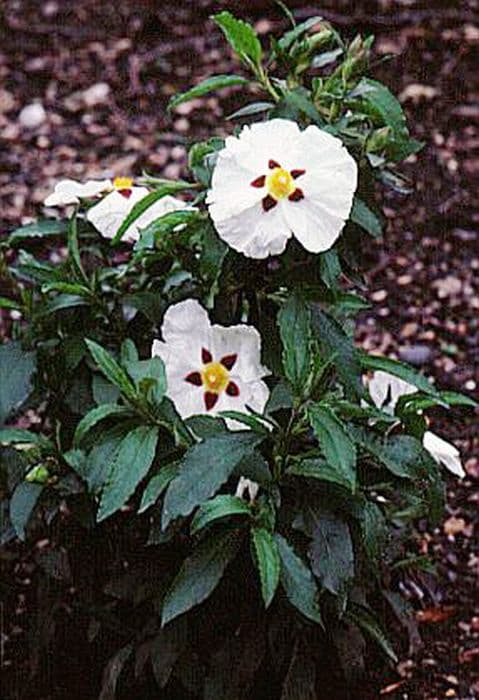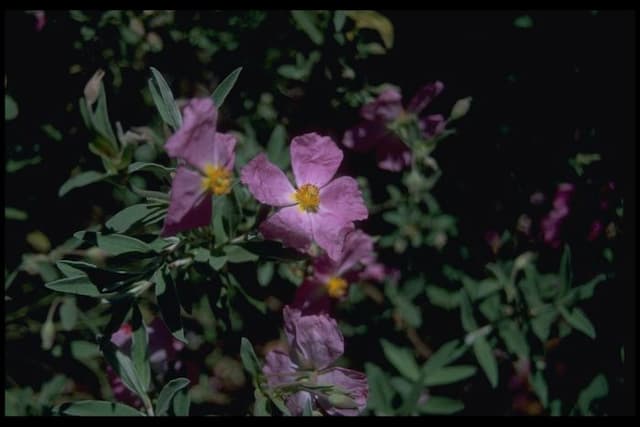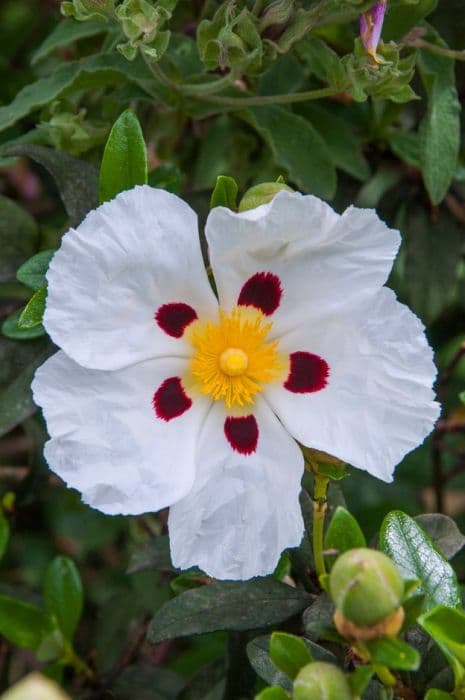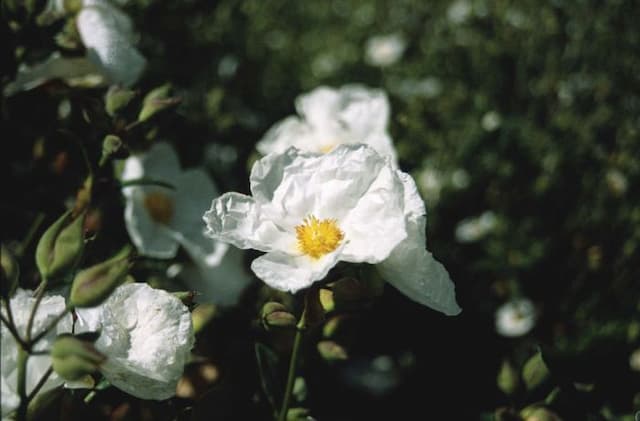Rock Rose Helianthemum 'Henfield Brilliant'

ABOUT
The Helianthemum 'Henfield Brilliant', also known as rock rose, is a captivating plant that boasts a multitude of vivid orange flowers which present a striking visual against the backdrop of its foliage. The flowers are radiant and bowl-shaped, exuding warmth and vibrancy that brighten any garden space. Each flower consists of five petals that are slightly ruffled at the edges, creating a somewhat delicate and informal look. The plant's foliage provides a lovely contrast to the bright flowers; it has small, narrow leaves that are silvery-green in color. These leaves are dense and create a fine-textured appearance, adding another layer of interest to this beautiful shrub. The foliage often appears to shimmer, due to the fine hairs that cover the leaves, giving them a sort of silken sheen. During its blooming season, the rock rose is covered in its characteristic flowers, offering a stunning display that is particularly eye-catching. This vibrant appearance makes it a popular choice for gardeners looking to add a splash of color to rockeries, borders, or ground cover. The Helianthemum 'Henfield Brilliant', with its bright flowers and contrasting foliage, is truly a plant that combines beauty with resilience.
About this plant
 Names
NamesFamily
Cistaceae
Synonyms
Rock Rose, Sunrose, Rushrose
Common names
Helianthemum 'Henfield Brilliant'
 Toxicity
ToxicityTo humans
The Rock Rose 'Henfield Brilliant' is not commonly known to be toxic to humans. While it is always advisable to avoid ingesting parts of plants that are not established as edible, there are no widespread reports of toxicity or poisoning from consuming this particular variety of Rock Rose. However, individuals may experience different reactions to plants, and it's possible to have an allergic response to any plant. If ingestion occurs and symptoms appear, it is crucial to seek medical advice.
To pets
Rock Rose 'Henfield Brilliant' is generally not considered toxic to pets. There is limited information suggesting any significant toxicity to cats, dogs, or other domestic animals from this plant. Nonetheless, it is always prudent to prevent pets from consuming plants not meant for their diet, as they can cause gastrointestinal upset or an allergic reaction in sensitive pets. If you suspect your pet has ingested Rock Rose and is displaying symptoms of distress, consult your veterinarian.
 Characteristics
CharacteristicsLife cycle
Perennials
Foliage type
Evergreen
Color of leaves
Green
Flower color
Orange
Height
1 foot [30 cm]
Spread
2 feet [60 cm]
Plant type
Shrub
Hardiness zones
5
Native area
Mediterranean
Benefits
 General Benefits
General Benefits- Drought Tolerance: The Rock Rose is highly resistant to dry conditions once established, making it suitable for xeriscaping.
- Low Maintenance: It requires minimal care beyond the initial establishment phase, perfect for low-maintenance gardens.
- Attracts Pollinators: This plant is attractive to bees and butterflies, which helps pollinate surrounding plants.
- Ground Cover: Its dense growth habit makes it an effective ground cover, reducing soil erosion and suppressing weeds.
- Sun-loving: It thrives in full sunlight, making it ideal for sunny areas where other plants might struggle.
- Colorful Blooms: The Rock Rose produces vibrant colorful flowers that can brighten up any landscape.
- Deer Resistance: The plant is usually resistant to deer, so it's less likely to be damaged by wildlife.
 Medical Properties
Medical PropertiesThis plant is not used for medical purposes.
 Air-purifying Qualities
Air-purifying QualitiesThis plant is not specifically known for air purifying qualities.
 Other Uses
Other Uses- Rock garden accent. Helianthemum 'Henfield Brilliant', commonly known as Rock Rose, can be used to create a focal point or add a splash of color in rock gardens due to its bright orange flowers.
- Butterfly attraction. The vibrant Rock Rose can serve as a nectar source for butterflies, enhancing biodiversity in a garden space.
- Slope stabilization. Because of its low-growing, mat-forming habit, Rock Rose can be used to control erosion on slopes.
- Living mulch. Gardening enthusiasts may use Rock Rose to cover the ground and suppress weeds, functioning as a living mulch that also contributes aesthetic appeal.
- Edging for pathways. Its compact growth pattern makes Rock Rose suitable for lining garden paths, providing a neat edge to the walkway.
- Horticultural therapy. The act of caring for a Rock Rose can be therapeutic and is sometimes included in horticultural therapy programs due to its ease of cultivation and bright disposition.
- Photography subject. Its striking flowers make Rock Rose a great subject for garden photographers and nature enthusiasts looking to capture the beauty of plants.
- Drought-tolerant displays. In regions prone to drought, Rock Rose is an excellent choice for xeriscaping, or creating landscapes that reduce or eliminate the need for irrigation.
- Potted gardens. Rock Rose can be grown in containers on patios or balconies, ideal for those with limited space but who wish to enjoy its beauty.
- Ecological education. As a plant that attracts pollinators, Rock Rose can be incorporated into educational programs teaching about the importance of pollinators in ecosystems.
Interesting Facts
 Feng Shui
Feng ShuiThe Rock Rose is not used in Feng Shui practice.
 Zodiac Sign Compitability
Zodiac Sign CompitabilityThe Rock Rose is not used in astrology practice.
 Plant Symbolism
Plant Symbolism- Persistence: The common name of Helianthemum 'Henfield Brilliant' is Rock Rose, which symbolizes persistence due to its ability to survive in rocky, challenging environments, representing the idea of thriving against the odds.
- Beauty: Rock Rose is known for its beautiful, vibrant flowers, which symbolize the notion that beauty can be found even in harsh conditions, reminding us of the resilience and beauty of life.
- Survival: As a plant that can withstand drought and poor soil, Rock Rose represents survival and the ability to endure difficult circumstances.
- Protection: Traditionally, some species of Rock Rose were used in folk medicine; this gives the plant an association with protection and healing.
 Water
WaterThe Rock Rose should be watered deeply but infrequently, allowing the soil to dry out slightly between waterings. This could mean watering approximately once a week during hot, dry periods, with less frequent watering during cooler, wetter seasons. Generally, applying about one to two gallons of water to the base of the plant, depending on its size and the soil conditions, should suffice. Over-watering can lead to root rot, so it’s crucial to ensure good drainage and not to let the plant sit in waterlogged soil.
 Light
LightRock Rose thrives in full sun conditions, which means it should receive at least six hours of direct sunlight daily for optimal growth. It performs well in a south-facing garden where it can bask in the warm sun throughout the day, making it crucial to position it in a spot that isn't shadowed by taller plants or structures.
 Temperature
TemperatureRock Rose prefers a warm climate and can typically withstand temperatures down to about 10 degrees Fahrenheit, but should be protected from extreme cold. This plant thrives best in temperatures ranging from 60 to 80 degrees Fahrenheit. Prolonged exposure to temperatures below 10 degrees Fahrenheit may damage or kill the plant.
 Pruning
PruningPruning the Rock Rose is important for maintaining a compact shape and encouraging vigorous flowering. It should be pruned in early spring to remove any dead or damaged wood and to shape the plant. Also, after blooming, it's beneficial to lightly prune to deadhead spent flowers and encourage a second bloom. Pruning can be done annually or as needed to keep the plant looking tidy.
 Cleaning
CleaningAs needed
 Soil
SoilRock rose 'Henfield Brilliant' thrives best in well-drained soil with a mix of loam, sand, and grit, in a neutral to alkaline pH range between 6.0 and 8.0.
 Repotting
RepottingRock rose 'Henfield Brilliant' generally doesn't need frequent repotting; it should be done every 2 to 3 years to refresh the soil, or when it outgrows its pot.
 Humidity & Misting
Humidity & MistingRock rose 'Henfield Brilliant' prefers a dry environment and does well in low humidity conditions typical of outdoor settings.
 Suitable locations
Suitable locationsIndoor
Ensure bright light, good airflow, and use a gritty soil mix.
Outdoor
Plant in full sun with well-draining soil; protect from severe cold.
Hardiness zone
Rock rose 'Henfield Brilliant' is suitable for USDA zones 5-9.
 Life cycle
Life cycleThe life cycle of the Helianthemum 'Henfield Brilliant', commonly known as the Rock Rose, begins with seed germination, occurring in spring under favorable conditions of warmth and moisture. Seedlings establish a root system and develop a rosette of leaves at the soil level. As they mature, stems elongate and foliage expands, with the plants forming a woody base characteristic of shrubby perennials. Flowering typically happens in late spring to early summer, producing vibrant orange blooms that attract pollinators and may lead to the formation of seed capsules if fertilization occurs. After the flowering stage, the plant may enter a period of dormancy, especially in hot summer climates, to conserve energy. With the arrival of cooler temperatures or the onset of the next growing season, the Rock Rose can resume growth, continuing its perennial cycle.
 Propogation
PropogationPropogation time
Spring-Early Summer
Propogation: The Helianthemum 'Henfield Brilliant', commonly known as the rock rose, is typically propagated during late winter to spring before new growth begins. The most popular method of propagation for rock rose is through semi-hardwood cuttings. To propagate rock rose cuttings, one should select a healthy, non-flowering stem and cut a segment around 4 to 6 inches (10 to 15 centimeters) long. Strip the lower leaves and dip the cutting end in rooting hormone powder to encourage root growth. The cutting should then be planted in a mix of half peat and half perlite or sand, ensuring that the leafless part of the stem is beneath the soil. The pot should be kept in a warm, well-lit area but out of direct sunlight, with the soil kept moist but not waterlogged. Roots typically develop within a few weeks, after which the new rock rose plants can be gradually acclimatized to outdoor conditions before transplanting.









